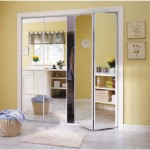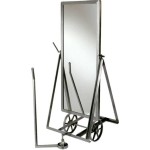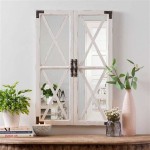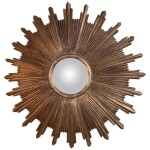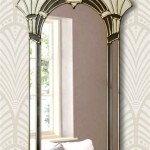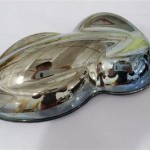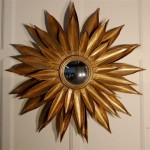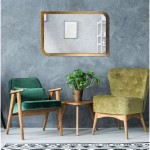Are Starburst Mirrors Out of Style?
Starburst mirrors, with their radiating patterns reminiscent of celestial explosions, experienced a surge in popularity during the mid-20th century and enjoyed a significant resurgence in the early 2000s. These mirrors, characterized by a central reflective surface surrounded by a frame of radiating spokes, often crafted from metal, wood, or plastic, added a touch of glamour and mid-century modern flair to homes. The question of whether starburst mirrors are currently "out of style" is complex and requires careful consideration of evolving design trends, individual preferences, and the enduring appeal of certain aesthetic elements.
To determine the current status of starburst mirrors in the interior design landscape, it's essential to examine their historical context, analyze their strengths and weaknesses as design elements, and evaluate their presence in contemporary homes and retail spaces. This involves understanding how decorative trends ebb and flow, considering the versatility of starburst mirrors in various design styles, and recognizing the impact of personalized expression in interior design.
The Cyclical Nature of Design Trends and the Starburst Mirror's History
Interior design, like fashion, operates within a cyclical framework. What is considered trendy today might be deemed outdated tomorrow, only to resurface again in the future with renewed appeal. This cyclical nature is heavily influenced by social, economic, and technological factors. The popularity of starburst mirrors can be traced back to the mid-20th century, a period marked by optimism, technological advancements, and a desire for modern aesthetics. The starburst design, with its geometric precision and sense of dynamic energy, resonated with the era's forward-thinking spirit.
The resurgence of mid-century modern design in the early 2000s brought with it a renewed appreciation for starburst mirrors. As homeowners sought to recreate the iconic looks of the 1950s and 1960s, these mirrors became a sought-after accessory. However, as design preferences shifted towards more minimalist and contemporary styles, the prominence of starburst mirrors began to wane. This ebb and flow is a common characteristic of design trends, highlighting the importance of understanding the historical context when evaluating the enduring appeal of a specific design element.
Currently, the interior design landscape embraces a diverse range of styles, with a focus on functionality, sustainability, and personalization. While some might perceive starburst mirrors as dated, their ability to evoke a specific era and add a touch of glamour ensures their continued presence in certain design schemes. The key is understanding how to incorporate them effectively within a modern context, rather than blindly adhering to outdated trends.
The Strengths and Weaknesses of Starburst Mirrors as Design Elements
Starburst mirrors possess both inherent strengths and potential weaknesses that contribute to their perceived style status. One of their primary strengths lies in their ability to function as focal points within a room. The radiating design draws the eye and creates a sense of visual interest, making them suitable for placement above fireplaces, consoles, or in entryways. Their reflective surface also enhances the brightness of a space by bouncing light, contributing to a more open and airy atmosphere.
Furthermore, starburst mirrors can complement a variety of design styles, depending on their material and finish. A gold-toned metal starburst mirror can add a touch of Art Deco glamour, while a wooden version can bring a rustic or bohemian vibe. Their versatility allows them to be incorporated into eclectic, mid-century modern, and even contemporary spaces, provided they are chosen carefully and integrated thoughtfully.
However, starburst mirrors also have potential drawbacks. Their intricate design can sometimes feel overwhelming or cluttered, particularly in smaller rooms or spaces with already busy patterns. Their association with a specific era can also make them feel dated if not properly integrated into a contemporary setting. Overuse of starburst mirrors throughout a home can also lead to a monotonous and repetitive aesthetic, diminishing their impact as individual statement pieces.
The key to successfully incorporating starburst mirrors is to strike a balance between their decorative appeal and the overall design integrity of the space. Choosing a size appropriate for the room, selecting a finish that complements the existing color palette, and avoiding excessive use are all crucial considerations.
The Enduring Appeal of Unique Expression and Personalized Style
Ultimately, the question of whether starburst mirrors are "out of style" is subjective and depends heavily on individual preferences and the overall design vision for a home. Interior design is increasingly moving away from rigid adherence to trends and towards a more personalized approach, where homeowners are encouraged to curate spaces that reflect their unique tastes and experiences.
In this context, starburst mirrors can serve as valuable tools for expressing individuality and adding a touch of personality to a room. Whether they are vintage finds, contemporary interpretations, or DIY creations, starburst mirrors can be incorporated into designs that tell a story and evoke a sense of personal connection. The key is to move beyond the notion of "in" or "out" and focus on creating spaces that are authentic, comfortable, and visually appealing to the individual homeowner.
Furthermore, the principles of good design remain timeless, regardless of current trends. Scale, proportion, balance, and harmony are all essential elements that contribute to a successful interior design scheme. A well-placed starburst mirror, even if deemed "outdated" by some, can still enhance the visual appeal of a room if it adheres to these fundamental principles. The emphasis should be on creating a cohesive and balanced design that reflects the homeowner's personal style, rather than slavishly following fleeting trends.
The adaptability of the starburst mirror design is also a factor in its continued relevance. Modern interpretations often incorporate updated materials, finishes, and sizes, allowing them to blend seamlessly into contemporary spaces. Designers are also finding innovative ways to incorporate the starburst motif into other decorative elements, such as lighting fixtures, wall art, and furniture details, demonstrating its enduring versatility.
Therefore, instead of dismissing starburst mirrors as outdated, it is more accurate to view them as design elements with a rich history and the potential for continued relevance. Their incorporation into contemporary homes depends on careful consideration of their strengths and weaknesses, their integration within a cohesive design scheme, and the homeowner's individual preferences. The key is to embrace the principles of good design and prioritize personalized expression over blind adherence to fleeting trends, ensuring that starburst mirrors, and other potentially "outdated" elements, can continue to contribute to beautiful and functional living spaces.

Sunburst Mirrors Are The Omnipresent Home Decor I Can T Stop Noticing Vox

Sunburst Mirrors What They Are Where Came From And Why We Love Them

Sunburst Mirrors Are The Omnipresent Home Decor I Can T Stop Noticing Vox

Sunburst Mirrors What They Are Where Came From And Why We Love Them

Timeless Or Trendy Sunburst Mirrors Centsational Style

Which Mirror Type Reflects Your Interior Design Style The Kuotes Blog

Sunburst Mirrors What They Are Where Came From And Why We Love Them

Which Mirror Type Reflects Your Interior Design Style The Kuotes Blog

Diy Sunburst Mirror Edith Evelyn

Suzanne Kasler Sunburst Mirror 4

